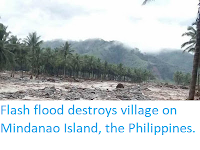Three people have been confirmed dead after Typhoon Mangkhut (known in the Philippines as Typhoon Ompong) made landfall in Cagayan Province on northen Luzon Island at about 1.40 am local time on Saturday 15 September 2018 (about 5.40 pm on Friday 14 September GMT). brining with it sustained winds of 270 kilomtres per hour, and gusts of up to 325 kilometres per hour. Two of the deaths have been confirmed as female emergency workers caught in one of the many landslides triggered by the storm. Landslides
are a common problem after severe weather events, as excess pore water
pressure can overcome cohesion in soil and sediments, allowing them to
flow like liquids. Approximately 90% of all landslides are caused by
heavy rainfall.
Man caught by a storm surge in Manila Bay associated with Typhoon Magkhut on 15 September 2018. Mark Cristino/EPA/EFE.
Typhoon Mangkhut is the most severe storm anywhere in the world of 2018, and the worst storm to hit the Philippines since Typhoon Haiyan in 2013, which killed over 6000 people. A similarly large death toll from Typhoon Magkhut has largely been avoided by large scale evacuations of low lying areas in the path of the storm, triggered by warnings from meteorologists that the storm might cause storm surges of up to nine metres. Similatr evacuations are now underway in Hong Kong, Macau, and parts of South China, which are predicted to be hit by the storm will hit within the next two days. Tropical storms loose energy as they pass over land, eventually disapaiting, and this has been true of Mangkhut as it crossed Luzon island, becoming less severe as it moved westward, however it is still a very powerful storm, and is expected to gain energy again once it clears Luzon and passes over the South China Sea.
The path and strength of Typhoon Mangkhut. Thick line indicates the
past path of the storm (till 6.00 am GMT on Saturday 15 September 2018),
while the thin line indicates the predicted future path of the storm,
and the dotted circles the margin of error at 12, 24, 36 and 72 hours
ahead. Colour indicated the severity of the storm. Tropical Storm Risk.
Tropical storms are caused by the warming effect of the Sun over
tropical seas. As the air warms it expands, causing a drop in air
pressure, and rises, causing air from outside the area to rush in to
replace it. If this happens over a sufficiently wide area then the
inrushing winds will be affected by centrifugal forces caused by the
Earth's rotation (the Coriolis effect). This means that winds will be
deflected clockwise in the northern hemisphere and anti-clockwise in the
southern hemisphere, eventually creating a large, rotating Tropical
Storm. They have different names in different parts of the world, with
those in the northwest Atlantic being referred to as hurricanes.
Despite the obvious danger of winds of this speed, which can physically
blow people, and other large objects, away as well as damaging buildings
and uprooting trees, the real danger from these storms comes from the
flooding they bring. Each drop millibar drop in air-pressure leads to an
approximate 1 cm rise in sea level, with big tropical storms capable of
causing a storm surge of several meters. This is always accompanied by
heavy rainfall, since warm air over the ocean leads to evaporation of
sea water, which is then carried with the storm. These combined often
lead to catastrophic flooding in areas hit by tropical storms.
See also...
Follow
Sciency Thoughts on Facebook.









